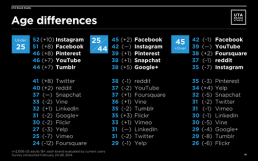How Instagram is Becoming the New Facebook for Brands
Brands were recently hit with an algorithmic change on Facebook aptly dubbed “Facebook armageddon,” which prioritizes “meaningful interactions” and posts from your friends and family over posts from brands. Of course, mass panic ensued. For years, Facebook has been the spot for brands to advertise and build a social following. Then suddenly, Facebook gathered all of our things and through them into the street like a cruel ex-boyfriend. Big brands owned by rockstar/scientist Elon Musk, Tesla and SpaceX, have already deleted their Facebook pages – the equivalent to, well, deleting their ex on Facebook.
Luckily, there’s another suitor in town: Instagram. Instagram, though owned by Facebook, may become the new love interest of big brands. It’s young (the majority of Instagram’s users are under 30), adaptable, and its users are fiercely loyal to brands they love (roughly 53 percent of Instagram users follow brands).
So, is it time for brands to cut ties with their cold and fickle ex, Facebook, in favour of Instagram? Maybe – and here’s why.
Adaptability
Instagram has proven its ability to quickly embrace new trends and technology – and does it really well. Take Instagram Stories, for instance. After Instagram blatantly copied Snapchat (RIP) with Instagram Stories, they saw a growth of 300 million users. Then, they stole Snapchat’s filters, effectively digging a knife into the once almighty ghost (afterwhich Snapchat finished the job themselves with their recent ill-advised advertising fiasco). And even after Instagram adopting the algorithmic timeline approach à la Facebook, versus the chronological timeline of the past, the platform’s user base is still growing.
Translation: Instagram’s continually changing interface and dynamic ability to adapt promises sustainable user growth moving forward.
Engagement
Sure, Facebook has 2 billion users making it the untouchable king of reach. But the king better guard his crown, because engagement on Instagram is unparalleled by any other major social media platform – though it has dropped since the decline of organic reach. Recent studies found that brands are seeing up to three times higher user engagement on Instagram than they are on Facebook, and afterall, isn’t engagement what we all want? Why settle for someone passively looking at your content mid-scroll, when you have another audience ready to put a ring on it – metaphorically speaking. Take Mercedes-Benz, for example. They posted a photo of their new A-Class on Facebook and quickly got 10,000 likes. When they posted the same photo on Instagram: 150,000 likes.
Granted, Instagram does have an inherent leg up on Facebook. The visual-based platform, at its core, is a hub for sharing pretty photos – a lot of pretty photos. As users scroll through their feed, the content is right there, making it easy to toss out likes like Oprah giving away free cars. And, importantly, there is no “dislike” button on Instagram.
Embracing Brands
While Facebook is pushing brands away, Instagram is pulling them in for a big bear hug. With the latest algorithm update on Facebook, updates from friends and family are being prioritized over posts and ads from brands. Okay, fair. A post from a brand sticks out like a sore thumb when mixed among status updates from your grandma and your weird aunt sharing photos of her latest sewing venture. On Instagram, however, branded content blends right in – especially content from brands who have mastered the art of gorgeous visuals. Plus, with the Explore Tab, posts by brands can be discovered by users outside of their current followers, essentially rewarding brands with good feeds. Instagram has also added a shopping feature, allowing brands to include a direct link to purchase the products shown in their photos. Can it get any easier?
More Sophisticated Tools
Facebook has long been the platform of choice for advertisers – primarily for its ability to refine your audience down to location, behaviours, jobs, and interests. No other platform could give you that kind of bang for your buck – until Instagram opened up to ads in 2015 and quickly introduced Facebook’s advertising functionality. They have since created innovative ways to advertise, such as opening up Instagram Stories to canvas ads. Not surprisingly, the number of brands advertising on Instagram jumped to two million last year – which, like our coffee consumption, roughly doubled over the previous year. With projected ad revenue of $11 million in 2019, it doesn’t look they’ll be slowing down any time soon.
Need help making the most of Instagram, or figuring out which platforms work the best for your business? We’d love to talk.



